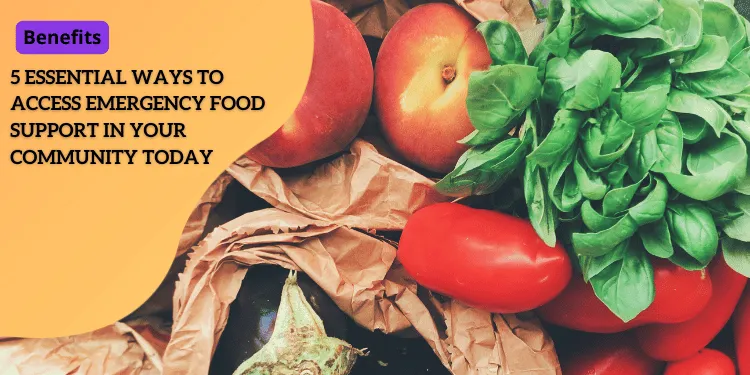5 Essential Ways to Access Emergency Food Support in Your Community Today

Anúncios
1. Understanding Emergency Food Support
What Qualifies as Emergency Food Assistance
Emergency food assistance is meant to provide immediate relief to individuals and families experiencing food insecurity.
This aid typically includes non-perishable food items, ready-to-eat meals, and sometimes fresh produce.
Anúncios
The primary goal is to ensure that no one goes hungry while they figure out a more stable, long-term food security plan.
 People in need are entitled to food assistance
People in need are entitled to food assistance
Importance of Immediate Access to Food Resources
Immediate access to food resources is crucial for several reasons.
Anúncios
First, it addresses the immediate need of hunger, which can impair cognitive and physical functions, making daily activities hard to manage.
Second, it helps create a sense of security and stability, essential for mental well-being.
Immediate food support can also connect people to additional services, such as social support networks and financial counseling, facilitating a more comprehensive approach to regaining independence.
Types of Organizations Providing Emergency Food Support
Several types of organizations come together to offer emergency food assistance:
- 🍲 Government Agencies: Programs like the Supplemental Nutrition Assistance Program (SNAP) offer quick access to benefits. Additionally, local government agencies can provide connections to food banks and community kitchens.
- 🍲 Non-Profit Organizations: Many non-profit organizations focus on alleviating hunger. National networks like Feeding America and local food banks distribute food among community members in need.
- 🍲 Religious Institutions: Churches, mosques, synagogues, and other places of worship often run food pantries and soup kitchens. Many of these institutions focus on serving underserved and low-income communities.
- 🍲 Community Organizations: Local community centers and groups frequently sponsor food drives, organize meal programs, and provide other forms of food assistance tailored to their neighborhoods’ needs.
Understanding the roles and functions of these various organizations can help you quickly find the support you need.
Immediate food assistance resources are essential for alleviating the pressing issue of hunger and paving the way for long-term solutions.
2. Government Assistance Hotlines
Dialing 211 for Local Food Assistance Connections
If you or someone you know is experiencing hunger and needs immediate food assistance, a quick and effective way to find help is by dialing 211.
This nationwide service connects you with local agencies and community organizations that can provide emergency food resources.
By simply calling 211, you’ll be linked to a network of support that includes food banks, hot meal programs, shelters, and other services tailored to meet urgent needs.
USDA National Hunger Hotline (1-866-3-HUNGRY)
Another essential resource is the USDA National Hunger Hotline.
By calling 1-866-3-HUNGRY (1-866-348-6479), anyone in need can receive information and support in accessing emergency food programs.
The hunger hotline operates Monday through Friday, from 7:00 AM to 10:00 PM Eastern Time, making it a convenient option for those needing help during the week.
The hotline is staffed with knowledgeable individuals who can provide referrals to local food pantries, meal sites, and other nutrition assistance programs.
Spanish Language Support through 1-877-8-HAMBRE
For Spanish-speaking individuals, the USDA National Hunger Hotline offers assistance through 1-877-8-HAMBRE (1-877-842-6273).
This service ensures that language barriers do not prevent anyone from accessing the support they need.
Like the English-language hotline, 1-877-8-HAMBRE operates Monday through Friday from 7:00 AM to 10:00 PM Eastern Time.
Operators are ready to offer guidance and connect individuals to local food resources and assistance programs in their community.
Utilizing these hotlines can swiftly guide you to the right resources and ensure that you get the help you need, precisely when you need it.
 Call if you need or know someone else
Call if you need or know someone else
Locating Local Food Pantries
Using Online Zip Code Locator Tools
Finding local food pantries has never been easier, thanks to the power of online zip code locators.
Websites like FeedingAmerica.org allow you to simply enter your zip code and instantly receive a list of nearby food pantries.
This tool is incredibly helpful for those who need immediate food assistance but are unaware of the local resources available to them.
It provides not just the locations but often the hours of operation and contact information, making it easier to plan your visit.
Identifying Nearby Food Banks
Food banks play a critical role in emergency food support, and knowing how to find one near you can make a significant difference.
Start by visiting these food banks’ websites or calling their hotlines if they have one.
Most food banks also have a search function on their website where you can enter your zip code to find a partner agency or distribution center near you.
This direct approach helps you identify which food banks can quickly serve your immediate needs.
Accessing Community Food Distribution Centers
Community food distribution centers are another valuable resource for those in need of emergency food support.
These centers often work in tandem with local government and non-profits to distribute food to those in need.
To locate these centers, you can check community bulletin boards, local news websites, or social media groups.
Don’t hesitate to call your town or city hall as they often have the latest information on community resources and upcoming food distribution events.
Being aware of these options ensures you’re not helpless when hunger strikes.
By utilizing online tools, identifying nearby food banks, and accessing community distribution centers, you can find the emergency food support you need swiftly and efficiently.
Taking these steps will empower you to secure resources quickly, ensuring no one in your household goes hungry.
4. Community and Religious Organization Support
Connecting with Local Religious Institutions for Food Assistance
Many local religious institutions provide vital food assistance services, recognizing the importance of helping community members in times of need.
Churches, mosques, synagogues, and other places of worship often have food pantries or meal programs to support those facing hunger.
These organizations might offer:
- 🥕 Weekly or monthly food distributions
- 🥕 Soup kitchens providing hot meals
- 🥕 Holiday-specific food drives and meal services
To find such support, contact local religious institutions directly or visit their websites.
Many are well-connected to broader food assistance networks and can guide you to additional resources.
Community Organizations Offering Emergency Food Services
Beyond religious institutions, numerous community organizations are dedicated to providing emergency food services.
Non-profit organizations and local community centers often operate food programs designed to assist during crises.
These can include:
- 🥔 Community food pantries: Distributing non-perishable food items regularly
- 🥔 Meal delivery services: Especially for seniors or individuals with disabilities
- 🥔 Community meals: Events where meals are shared, fostering support and camaraderie
To locate these services, consider reaching out to your local community center or checking if nearby non-profits have food assistance initiatives.
Websites like Feeding America also offer locator tools to find nearby resources.
Navigating Faith-Based Food Support Programs
Faith-based organizations significantly contribute to emergency food support through structured food programs often embedded within their charitable missions.
These programs might include:
- 🍗 Faith-based food banks: Larger operations pooling resources from various congregations
- 🍗 Emergency food boxes: Pre-assembled boxes containing essential groceries for immediate use
- 🍗 Partnerships with local farms or food producers: Providing fresh produce to those in need
These programs can be navigated by visiting the organization’s website or contacting them directly.
Many faith-based organizations also collaborate with other local services to form a comprehensive support network, ensuring broader community coverage.
Community and religious organizations play a crucial role in food assistance, ensuring that immediate relief is available to those in need.
By leveraging these valuable resources, individuals can find both immediate and long-term support, reducing the stress caused by food insecurity.
5. Taking Immediate Action
When hunger strikes and you need food now, knowing what to do next is crucial.
Here’s a streamlined process to make sure you get the help you need quickly.
Steps to Access Same-Day Food Assistance
- Contact Local Hotlines: Start by calling 211, which will connect you with local agencies and organizations that can provide immediate assistance. If you’re struggling to find food, call the USDA National Hunger Hotline at 1-866-3-HUNGRY (1-866-348-6479) or 1-877-8-HAMBRE (1-877-842-6273) for Spanish support. These hotlines operate Monday through Friday, 7:00 AM to 10:00 PM Eastern Time.
- Use Online Locators: Visit FeedingAmerica.org to use their zip code locator tool and pinpoint nearby food pantries or meal programs. This tool is user-friendly and provides quick results, getting you the help you need without delay.
- Reach Out to Community Centers: Many community and religious organizations offer emergency food support. Contact local churches, mosques, synagogues, or community centers to ask about their food assistance programs. These organizations often have food pantries or can guide you to nearby resources.
Required Documentation for Emergency Food Support
Before you head to a food pantry or other assistance program, gather any required documentation.
While specifics can vary, typical documents include:
- 🍝 Proof of Identity: ID card, driver’s license, or passport
- 🍝 Proof of Residence: Utility bill, lease agreement, or mail addressed to you
- 🍝 Income Verification: Recent pay stubs, a letter from an employer, or documents showing unemployment benefits
Having these ready will streamline the process and ensure you receive assistance without unnecessary delays.
Following Up with Long-Term Food Security Resources
Once you’ve secured immediate food assistance, think about your ongoing needs.
Consider applying for long-term food security programs like:
- 🥖 Supplemental Nutrition Assistance Program (SNAP): Provides monthly food benefits.
- 🥖 Women, Infants, and Children (WIC): Offers assistance for pregnant women, new mothers, and young children.
- 🥖 Local Food Banks: Many provide recurring support and resources for continued assistance.
Contacting these programs and organizations can help ensure you have a stable, long-term plan to avoid future food crises.






